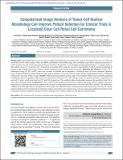Files in this item
Computerized image analysis of tumor cell nuclear morphology can improve patient selection for clinical trials in localized clear cell renal cell carcinoma
Item metadata
| dc.contributor.author | Um, In Hwa | |
| dc.contributor.author | Scott-Hayward, Lindesay | |
| dc.contributor.author | MacKenzie, Monique Lea | |
| dc.contributor.author | Tan, Puay Hoon | |
| dc.contributor.author | Kanesvaran, Ravindran | |
| dc.contributor.author | Choudhury, Yukti | |
| dc.contributor.author | Caie, Peter David | |
| dc.contributor.author | Tan, Min-Han | |
| dc.contributor.author | O'Donnell, Marie | |
| dc.contributor.author | Leung, Steve | |
| dc.contributor.author | Stewart, Grant | |
| dc.contributor.author | Harrison, David James | |
| dc.date.accessioned | 2020-11-11T15:30:11Z | |
| dc.date.available | 2020-11-11T15:30:11Z | |
| dc.date.issued | 2020-11-06 | |
| dc.identifier | 271173378 | |
| dc.identifier | e43af4e0-2076-4f36-914d-4b750897956c | |
| dc.identifier.citation | Um , I H , Scott-Hayward , L , MacKenzie , M L , Tan , P H , Kanesvaran , R , Choudhury , Y , Caie , P D , Tan , M-H , O'Donnell , M , Leung , S , Stewart , G & Harrison , D J 2020 , ' Computerized image analysis of tumor cell nuclear morphology can improve patient selection for clinical trials in localized clear cell renal cell carcinoma ' , Journal of Pathology Informatics , vol. 11 , 35 . https://doi.org/10.4103/jpi.jpi_13_20 | en |
| dc.identifier.issn | 2153-3539 | |
| dc.identifier.other | ORCID: /0000-0002-8505-6585/work/83481370 | |
| dc.identifier.other | ORCID: /0000-0003-3402-533X/work/83481408 | |
| dc.identifier.other | ORCID: /0000-0001-9041-9988/work/83481841 | |
| dc.identifier.other | ORCID: /0000-0002-0031-9850/work/83481916 | |
| dc.identifier.other | ORCID: /0000-0001-9999-4292/work/158122919 | |
| dc.identifier.uri | https://hdl.handle.net/10023/20952 | |
| dc.description | The study was supported by Laboratory Medicine R&D Fund and iCAIRD. | en |
| dc.description.abstract | Background: Clinicopathological scores are used to predict the likelihood of recurrence-free survival for patients with clear cell renal cell carcinoma (ccRCC) after surgery. These are fallible, particularly in the middle range. This inevitably means that a significant proportion of ccRCC patients who will not develop recurrent disease enroll into clinical trials. As an exemplar of using digital pathology, we sought to improve the predictive power of “recurrence free” designation in localized ccRCC patients, by precise measurement of ccRCC nuclear morphological features using computational image analysis, thereby replacing manual nuclear grade assessment. Materials and Methods: TNM 8 UICC pathological stage pT1-pT3 ccRCC cases were recruited in Scotland and in Singapore. A Leibovich score (LS) was calculated. Definiens Tissue studio® (Definiens GmbH, Munich) image analysis platform was used to measure tumor nuclear morphological features in digitized hematoxylin and eosin (H&E) images. Results: Replacing human-defined nuclear grade with computer-defined mean perimeter generated a modified Leibovich algorithm, improved overall specificity 0.86 from 0.76 in the training cohort. The greatest increase in specificity was seen in LS 5 and 6, which went from 0 to 0.57 and 0.40, respectively. The modified Leibovich algorithm increased the specificity from 0.84 to 0.94 in the validation cohort. Conclusions: CcRCC nuclear mean perimeter, measured by computational image analysis, together with tumor stage and size, node status and necrosis improved the accuracy of predicting recurrence-free in the localized ccRCC patients. This finding was validated in an ethnically different Singaporean cohort, despite the different H and E staining protocol and scanner used. This may be a useful patient selection tool for recruitment to multicenter studies, preventing some patients from receiving unnecessary additional treatment while reducing the number of patients required to achieve adequate power within neoadjuvant and adjuvant clinical studies. | |
| dc.format.extent | 8 | |
| dc.format.extent | 1869913 | |
| dc.language.iso | eng | |
| dc.relation.ispartof | Journal of Pathology Informatics | en |
| dc.subject | Clear cell renal cell carcinoma | en |
| dc.subject | Computational image analysis | en |
| dc.subject | Leibovich score | en |
| dc.subject | RC Internal medicine | en |
| dc.subject | QA75 Electronic computers. Computer science | en |
| dc.subject | NDAS | en |
| dc.subject | SDG 3 - Good Health and Well-being | en |
| dc.subject.lcc | RC | en |
| dc.subject.lcc | QA75 | en |
| dc.title | Computerized image analysis of tumor cell nuclear morphology can improve patient selection for clinical trials in localized clear cell renal cell carcinoma | en |
| dc.type | Journal article | en |
| dc.contributor.institution | University of St Andrews. School of Medicine | en |
| dc.contributor.institution | University of St Andrews. Cellular Medicine Division | en |
| dc.contributor.institution | University of St Andrews. Statistics | en |
| dc.contributor.institution | University of St Andrews. Centre for Research into Ecological & Environmental Modelling | en |
| dc.contributor.institution | University of St Andrews. Office of the Principal | en |
| dc.contributor.institution | University of St Andrews. Scottish Oceans Institute | en |
| dc.contributor.institution | University of St Andrews. Sir James Mackenzie Institute for Early Diagnosis | en |
| dc.contributor.institution | University of St Andrews. Centre for Biophotonics | en |
| dc.identifier.doi | 10.4103/jpi.jpi_13_20 | |
| dc.description.status | Peer reviewed | en |
This item appears in the following Collection(s)
Items in the St Andrews Research Repository are protected by copyright, with all rights reserved, unless otherwise indicated.

